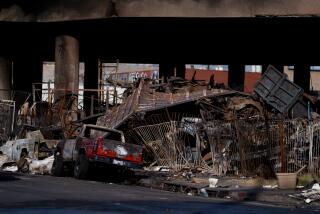Alleged plot’s damage would have been limited
The premise is right out of a disaster movie: Ignite the massive fuel tanks required to keep an international airport up and running each day, stand back, and watch a chain reaction of explosions throughout the labyrinth of pipelines running underneath the tarmac.
But aviation experts cautioned Saturday that the alleged plot targeting John F. Kennedy International Airport in New York would have faced many hurdles, not least of which is the fact that jet fuel does not easily explode.
“The level of catastrophe that may be created is much more limited than most people would expect,” said Rafi Ron, former head of security at Tel Aviv’s Ben Gurion International Airport. “The fuel that we are talking about is mostly jet fuel, which, unlike the gasoline most people put into their cars, is not that susceptible to explosion.”
That difficulty apparently concerned one of the alleged plotters -- an engineer who, federal authorities said in their complaint, explained to his associates that the tanks at JFK would probably require two explosions to provide enough oxygen to ignite the fuel.
But even then, aviation security experts said, fire would not have spread through the pressurized pipelines that bring fuel out to airplanes parked at gates.
“The probability that an explosion would travel through the pipeline and destroy targets along the tarmac is almost nil,” said Ron, now president of New Age Security Solutions in Rockville, Md. “The exception would be pipelines that are not in use and contain vapor.”
Jet fuel is similar to kerosene and, unlike gasoline, requires very high temperatures to burn. Unless it is in vapor or mist form -- which can occur in a plane crash -- jet fuel does not explode. Additives raise the flashpoint of jet fuel, further reducing the likelihood that it will burn, experts said.
Major airports worldwide use holding tanks and pipelines, usually underground, in a hydrant system that pumps fuel directly to the gates where airplanes are refueled. Readily available fuel is crucial to smooth operations.
A single long-range Boeing 747 jumbo jet such as those used to fly from Los Angeles to Melbourne, Australia, can hold more than 63,500 gallons. At Los Angeles International Airport, about 6 million gallons of jet fuel are stored on site and used daily, officials familiar with airport operations said. In addition, three pipelines carry off-site fuel to the airport.
The need to have so much fuel on hand has long created safety concerns. In Los Angeles, vulnerability to earthquake damage led to the creation of checks and balances for the airport’s fuel supplies.
The LAX fuel line system is computer-controlled, with sensors constantly monitoring pressure and temperature. The tanks, which have internal bladders to ensure that oxygen does not reach the liquid fuel, are designed to contain ruptures. The tanks also spray fire-retardant foam if the temperature rises above a specified level. Changes in pressure along the pipeline would trigger an immediate shutdown of that segment, according to officials familiar with airport operations.
Since the Sept. 11 terrorist attacks, airport security has added barriers to protect the fuel tanks.
LAX officials said Saturday that they had been in contact with international and federal law enforcement officials and were monitoring developments in the alleged JFK plot.
“We have added personnel and other resources according to established procedures until we learn more about the alleged terrorist plot,” Los Angeles World Airports officials said in a statement. “Additional measures will be unnoticed by the public. There are no current threats against any LAWA facilities, and all airport operations are normal.”
Ron, the aviation security expert, said that although the alleged plot was unlikely to have caused extensive damage, it should be taken seriously.
“For the last six years, most security has been focused at protection of aircraft and the screening of passengers,” said Ron who helped revamp security at Boston’s Logan International Airport after Sept. 11. “It’s not enough to screen passengers -- we need to protect the airports.”
More to Read
Sign up for Essential California
The most important California stories and recommendations in your inbox every morning.
You may occasionally receive promotional content from the Los Angeles Times.











